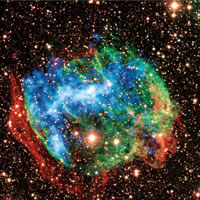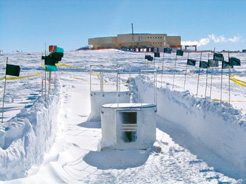
Exploring Matter and Energy in the Universe, page three

IceCube is designed to detect several neutrinos from a single gamma-ray burst of the kind that probably occurred in the supernova remnant W49B, located about 35,000 light-years from Earth and shown in a composite image from NASA's Chandra X-ray Observatory.
The Lab’s expertise in silicon detectors is matched by experience with another kind of detector invented here, the time projection chamber (TPC). At the heart of the STAR experiment at Brookhaven’s Relativistic Heavy Ion Collider, seeking the quark-gluon plasma that characterized one of the earliest phases of the universe, is a TPC built by Berkeley Lab. Both technologies will contribute to the detectors of the International Linear Collider, designed to complement CERN’s LHC by using lepton collisions to study high-energy events with more precision.
Some of the most elusive of fundamental particles are wispy, chargeless neutrinos. Luckily their reluctance to interact with matter is matched by their abundance, enough that a handful of the trillions upon trillions of neutrinos that pass through a reservoir of heavy water or mineral oil, or a cubic kilometer of transparent Antarctic ice, will betray their presence with flashes of pale Cherenkov radiation — perhaps a dozen interesting interactions a day, perhaps only a dozen a year, depending on their energy.

IceTop, a surface cosmic-ray detector array that forms part of the IceCube experiment, is being installed at the South Pole.
Berkeley Lab scientists and engineers designed and built the support structure for the 10,000 photomultiplier tubes of the Sudbury Neutrino Observatory (SNO), buried two kilometers deep in Ontario, Canada and designed to study neutrinos created in our sun. KamLAND, the Kamioka Liquid-scintillator Anti-Neutrino Detector that studies low-energy neutrinos from Japanese nuclear power plants, employs electronics designed, built, and installed by Berkeley Lab collaborators. At the heart of the IceCube astronomical observatory now under construction at the South Pole are the unique electronics of the digital optical modules (DOMs) designed here — eventually 80 strings of 60 DOMs each will dangle up to 2.5 kilometers under the ice, catching signals of high-energy cosmic neutrinos from the farthest reaches of space.
From the most elusive of Standard Model particles to yet-undiscovered particles, fields, and extra dimensions, Berkeley Lab physicists and engineers lead the cosmic search.